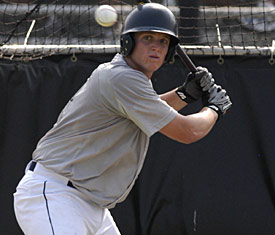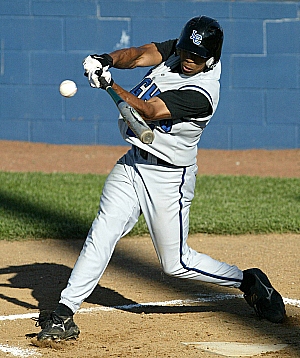October 29, 2007
Twins 2007 Minor League Numbers: Hitters
Before I get to the good stuff, please note that these are not my rankings of the Twins' top prospects. That annual list will be published later this offseason and includes both multi-year track records and long-term potential as huge factors, whereas the numbers below focus solely on what each player did this year. The point here is to simply determine who had the best 2007 season by putting everyone's numbers through the same context-adjusting system.
The first step is taking raw numbers and adjusting them for run-scoring environments, with the idea being that everyone should first be placed on an even playing field before evaluating their performance. For example, former first-round pick Chris Parmelee batted just .239/.313/.414 in 128 games at low Single-A, which looks horrible at first glance. However, the Midwest League as a whole batted just .255/.324/.372 while scoring 8.6 combined runs per game in 2007.
The run-scoring environment that Parmelee played in this season was about 12 percent worse for offense than MLB, which is a big part of his underwhelming numbers. Once you normalize the Midwest League to fit the level of offense found in MLB, then Parmelee's hitting line improves to .251/.325/.471. That's still not great, but it's well above average and clearly superior to his raw numbers while better showing the significant power potential that Parmelee (pictured below) possesses.
 Parmelee slugging just .414 this season is misleading, because he played in a league where hitting for power was exceptionally difficult. Once you account for that his adjusted slugging percentage jumps to .471, which shows him in a completely different light. Because the Twins' minor-league system is filled with teams playing in poor run-scoring environments, normalizing their organization-wide hitting numbers causes nearly every position player to receive a Parmelee-like boost.
Parmelee slugging just .414 this season is misleading, because he played in a league where hitting for power was exceptionally difficult. Once you account for that his adjusted slugging percentage jumps to .471, which shows him in a completely different light. Because the Twins' minor-league system is filled with teams playing in poor run-scoring environments, normalizing their organization-wide hitting numbers causes nearly every position player to receive a Parmelee-like boost.
Even after those adjustments the Twins still boast one of the weakest collections of hitting prospects in baseball, but as a group their position players weren't nearly as inept as the raw numbers suggest. Putting hitting prospects in leagues where the average team doesn't even slug .400 will do a lot to skew the perception of their ability and that's the case throughout the Twins' system. Once you account for run-scoring environments, here are the top adjusted 2007 hitting lines from Twins minor leaguers:
PA AVG OBP SLG OPS
Deibinson Romero 304 .328 .409 .560 .969
Ozzie Lewis 261 .337 .378 .584 .962
Ben Revere 216 .346 .393 .543 .936
Brian Buscher 431 .316 .388 .540 .928
Rene Leveret 283 .320 .403 .517 .920
Rene Tosoni 297 .314 .411 .478 .889
Brock Peterson 455 .290 .383 .505 .888
Danny Valencia 521 .308 .363 .518 .881
Brian Dinkelman 570 .280 .378 .493 .871
Matthew Macri 357 .298 .348 .519 .867
Erik Lis 539 .281 .340 .519 .859
Wilson Ramos 316 .306 .358 .498 .856
Johnny Woodard 436 .250 .361 .490 .851
Garrett Jones 446 .286 .338 .507 .845
Juan Richardson 220 .337 .368 .472 .840
Garrett Guzman 526 .318 .360 .480 .840
Dustin Martin 552 .298 .368 .470 .838
Luke Hughes 362 .288 .357 .464 .821
Mark Dolenc 265 .299 .384 .436 .820
Darnell McDonald 556 .304 .366 .454 .820
Steven Tolleson 571 .293 .395 .422 .817
Rashad Eldridge 407 .297 .361 .455 .816
Matt Tolbert 477 .300 .357 .457 .814
Jose Morales 411 .318 .370 .427 .797
Chris Parmelee 501 .251 .325 .471 .796
Juan Portes 552 .276 .342 .453 .795
Yangervis Solarte 203 .322 .346 .444 .790
Tommy Watkins 402 .278 .353 .433 .786
Joe Benson 507 .268 .360 .418 .778
Jeanfred Brito 229 .308 .333 .443 .776
Plenty of the organization's hitting prospects had solid seasons at the plate, although five of the top six came from rookie-ball players who batted under 300 times. Even adjusted, those numbers are the product of a small sample of playing time and should also be taken with a grain of salt for another reason that I'll get into momentarily. Among players who batted at least 400 times, Brian Buscher put together the best season with an adjusted hitting line of .316/.388/.540 between Double-A and Triple-A.
The trio of rookie-ball hitters whose seasons ranked above Buscher--Deibinson Romero, Ozzie Lewis, and Ben Revere--show the importance of the next step, which is making further adjustments for age and defensive position. In other words, how does each player's offense compare to other players at his position and how old was each player relative to the prospects he was playing against. If you take the normalized numbers above and apply further adjustments based on age and position, you get:
AGE LEVEL POS OPS%
Wilson Ramos 19 A- C 1.31
Deibinson Romero 20 RK/A- 3B 1.23
Ben Revere 19 RK CF 1.22
Jose Morales 24 AAA C 1.20
Trevor Plouffe 21 AA SS 1.17
Luke Hughes 22 AA 2B 1.15
Brock Peterson 23 AA 1B 1.13
Joe Benson 19 A- CF 1.13
Brian Buscher 26 AA/AAA 3B 1.12
Danny Valencia 22 A-/A+ 3B 1.11
Matt Tolbert 25 AAA 2B 1.11
Alexi Casilla 22 AAA 2B 1.11
Chris Parmelee 19 A- RF 1.10
Matthew Macri 25 AA/AAA 3B 1.10
Rene Tosoni 20 RK/A- RF 1.10
Brian Dinkelman 23 A-/A+ 2B 1.09
Ozzie Lewis 21 RK LF 1.08
Brandon Roberts 22 AA CF 1.07
David Winfree 21 AA 1B 1.07
Steven Tolleson 23 A+ SS 1.07
Garrett Guzman 24 AA LF 1.05
Juan Portes 21 A+ 3B 1.05
Johnny Woodard 22 A-/A+ 1B 1.05
Garrett Jones 26 AAA LF 1.05
Dustin Martin 23 A+ CF 1.04
Denard Span 23 AAA CF 1.04
Erik Lis 23 A+ LF 1.02
Tommy Watkins 27 AAA SS 1.02
Jeanfred Brito 19 RK 2B 1.02
Rashad Eldridge 25 AA CF 1.02
Shown above is a player's age this season, which level(s) he played at, which position he primarily manned, and how his context-adjusted offense compared to "average." For instance, Parmelee was 19 years old, spent the entire season at low Single-A, played primarily right field, and was about 10 percent above average offensively once everything was taken into account. The first list took only offense and run-scoring environment into account, while this list also factored in age and position.
The two rankings are very different and a look at the aforementioned rookie-ball trio of Romero, Lewis, and Revere helps shows why. All three players posted an adjusted OPS above .900 while playing at rookie-ball, but Romero and Revere stay at the top of the second list while Lewis drops from second to 17th. The reason for that is two-fold, with the first being that Lewis split time between left field and designated hitter, while Revere (pictured below) manned center field and Romero played third base.
 The further down the "defensive spectrum" that a player moves, the less impressive that his hitting becomes relative to other players at his position. In other words, a .900 OPS is much better coming from a shortstop than a first baseman. Lewis is essentially at the bottom of the defensive spectrum, while Revere is at the top and Romero is in the middle. Toss in their projected defensive value and it's easy to see why Lewis' .900 OPS doesn't look quite as impressive as it did initially.
The further down the "defensive spectrum" that a player moves, the less impressive that his hitting becomes relative to other players at his position. In other words, a .900 OPS is much better coming from a shortstop than a first baseman. Lewis is essentially at the bottom of the defensive spectrum, while Revere is at the top and Romero is in the middle. Toss in their projected defensive value and it's easy to see why Lewis' .900 OPS doesn't look quite as impressive as it did initially.
Beyond that, Revere and Romero both joined the Twins' system without playing college ball and played this season at 19 and 20 years old, respectively. Meanwhile, Lewis played three years at Fresno State before being drafted and was 21 years old this season. The difference between 19, 20, and 21 may not seem like much, but even one year is huge when it comes to projecting player development and evaluating someone's performance in the low minors.
Plenty of 21-years-olds who're drafted out of college thrive at rookie-ball, in large part because they're older and have more high-level experience than most of the players they're competing against. Plus, the Twins have several 21-year-olds already at Double-A. On the surface Romero, Lewis, and Revere had similar seasons offensively, but dig a little deeper and you can see that Lewis' year wasn't on the same level. The same logic also holds true beyond rookie-ball, although perhaps to a lesser extent.
Based purely on offense Garrett Jones had the 14th-best season of any hitter in the Twins' system, but he was also a 26-year-old playing his third season at Triple-A and was limited to first base or an outfield corner defensively. Once you take Jones' normalized numbers and adjust them further for his age and position, he drops to 24th on the list. While guys like Lewis and Jones move down on the second list, up-the-middle defenders who were young for their leagues move up.
In particular, adjusting for age and position pushes Wilson Ramos into the top spot after ranking 12th on the offense-only list. Ramos batted .291/.345/.438 at low Single-A, which works out to an adjusted hitting line of .306/.358/.498. That nice line gets even nicer when you consider that Ramos was a 19-year-old catcher. An .856 OPS from anyone is good, but an .856 OPS from a teenager manning arguably the most important defensive position while playing in a full-season league is fantastic.
Once you account for the run-scoring environment that he played in and adjust for both position and age, Ramos' 2007 season was about 31 percent above average offensively. That's an amazing year for a prospect who many observers think can potentially be a tremendous defensive catcher and Ramos leads the way among a total of 30 Twins minor leaguers who were above average offensively while batting at least 200 times.
Among hitters who came to the plate at least 400 times, Triple-A Rochester's Jose Morales--last seen suffering a gruesome ankle injury during a call-up with the Twins--was best at around 20 percent above average thanks to being a 24-year-old catcher with a .318/.370/.427 adjusted hitting line. Also having strong context-adjusted seasons in 400-plus plate appearances were Trevor Plouffe, Brock Peterson, Joe Benson, Danny Valencia, Matt Tolbert, Parmelee, and Buscher.
Once you're done here, check out my latest "Daily Dose" column over at Rotoworld.

